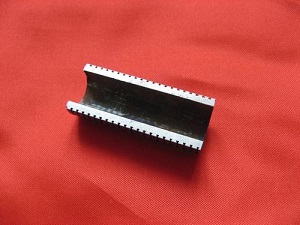Lord Fin Tube--Advantages of T shaped finned tube
What Are T-Shaped Finned Tubes? Enhanced Heat Transfer Technology
T-shaped finned tubes, also known as T-type screwed tubes, are specialized heat exchange components manufactured from high-quality materials including carbon steel, stainless steel, and copper. These advanced tubes represent a significant innovation in thermal technology, offering superior performance in various industrial applications.
Manufacturing Process and Design
The T-type finned tube is created through a precision rolling process applied to base light tubes. This manufacturing technique transforms the outer surface of the pipe into a series of spiral T-shaped tunnels that significantly enhance heat transfer capabilities. The unique design creates a large surface area while maintaining structural integrity.

Figure 1: T-shaped finned tube design showing spiral T-tunnels
Heat Transfer Mechanism
When tube media is heated within the T-shaped tunnels, a sequence of bubble nuclei is generated. The confined space of the tunnel cavities causes these nuclei to rapidly expand, filling the internal cavity. Continued heating leads to a rapid pressure increase within the bubbles, causing them to eject forcefully through the surface slits.
This forceful bubble ejection creates significant erosion force and induces a local negative pressure that draws surrounding cooler liquid into the T-shaped tunnels, resulting in continuous boiling action. This mechanism allows T-shaped finned tubes to carry away substantially more heat per unit surface area compared to conventional smooth tubes.
Advantages of T-Shaped Finned Tubes
- Enhanced Heat Transfer Efficiency: The boiling heat transfer coefficient of T-type tubes is 1.6-3.3 times higher than that of smooth tubes in R113 working medium, significantly improving overall system performance.
- Lower Temperature Boiling: While conventional heat exchangers require temperature differences of 12-15°C between hot and cold media to initiate boiling, T-type finned tube heat exchangers achieve boiling at just 2-4°C temperature difference. This results in denser, more continuous, and rapid boiling.
- Superior Performance Across Media: Extensive testing with various media including Freon 11 and liquid ammonia demonstrates consistently higher boiling heat coefficients compared to smooth tubes. In industrial applications, T-type finned tubes outperform smooth tubes by up to 99% under specific conditions.
- Cost-Effectiveness: T-shaped finned tubes offer significant cost advantages compared to alternative enhanced heat transfer tubes such as aluminum porous surface tubes, providing better value without compromising performance.
- Scale Prevention and Reduced Fouling: The intense gas and liquid disturbance within the T-shaped tunnels, combined with high-speed gas jets along the T-seam, minimize scaling on both the T-slot and outer tube surface. This anti-fouling characteristic ensures maintained heat transfer efficiency over extended operational periods.
- Long-Term Reliability: The robust construction and scale-resistant properties contribute to extended service life with minimal maintenance requirements.
Applications of T-Type Finned Tubes
T-shaped finned tubes serve as critical components in heat exchanger systems where they significantly enhance shell-side boiling heat transfer efficiency. These tubes are particularly valuable in applications where the shell-side medium remains relatively clean without solid particles or colloid impurities that could clog the T-shaped channels.
Common industrial applications include:
- Petrochemical processing heat exchangers
- Power plant condensers and evaporators
- Refrigeration and air conditioning systems
- Chemical processing equipment
- Waste heat recovery systems
- Marine and offshore heat exchange applications
- Pharmaceutical processing equipment
Technical Considerations
When implementing T-shaped finned tube heat exchangers, engineers should consider several factors including media compatibility, flow rates, temperature ranges, and pressure drop characteristics. Proper maintenance and cleaning procedures should be established to preserve the enhanced heat transfer properties over the equipments operational lifespan.
The innovative design of T-shaped finned tubes represents a significant advancement in heat transfer technology, offering improved efficiency, reduced energy consumption, and lower operating costs across numerous industrial applications. As thermal efficiency requirements become increasingly stringent, these advanced heat transfer components continue to gain prominence in the industry.

